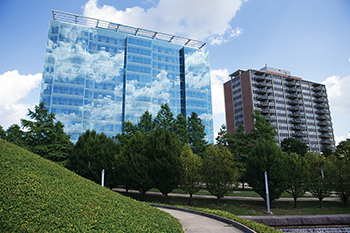Green Bonds Fund University of Cincinnati Renovation
 CINCINNATI — In December, the University of Cincinnati (UC) became the first public university in the country to issue Green Bonds for new construction. Then, the school began issuing the Series 2014C bonds to support the majority of costs related to the $35 million renovation of Scioto Hall. The project will increase the university’s housing capacity and was spurred by the school’s record fall enrollment of more than 43,600 students.
CINCINNATI — In December, the University of Cincinnati (UC) became the first public university in the country to issue Green Bonds for new construction. Then, the school began issuing the Series 2014C bonds to support the majority of costs related to the $35 million renovation of Scioto Hall. The project will increase the university’s housing capacity and was spurred by the school’s record fall enrollment of more than 43,600 students.
The university is designating this series as a Green Bond, as it meets the voluntary, best practices Green Bond Principles established in January 2014 by environmental finance experts and banks, according to Robert Ambach, the university’s senior vice president for administration and finance.
“Since sustainability is woven into all aspects of the university in terms of academics, research and extracurricular activities, it only made sense to further extend that to our financing,” Ambach said. “UC is already nationally recognized for our sustainable energy efficiencies and savings and our high-performance green buildings. That momentum will only continue at UC, and this step is an important milestone in our focus on sustainability.”
Scioto Hall, a 16-story, 142,000-square-foot building, has remained largely vacant since 2008. The building is one of the university’s iconic, 1960s-era Three Sisters residence halls, along with Morgens Hall, which was recently renovated by Richard Fleischman + Partners Architects Inc. of Cincinnati, and the now razed Sawyer Hall.
Similar to the work completed on Morgens Hall, the renovation will transform the underutilized Scioto Hall into a modern, energy-efficient, on-campus residence for approximately 450 University of Cincinnati upperclassmen. Beds will be spread across 140 apartment-style suites with a specific focus on energy efficiency and responsible material use, and construction is scheduled for completion in August 2016.
The renovation will replace the hall’s existing concrete and brick exterior with 2,000 high-tech glass panels, creating an attractive and energy-efficient facade. Each panel will include a half-inch of air space and have low-emissive properties, preventing heat loss or gain. These partially fritted panels will also feature a reflective pattern, decreasing solar heat gain by 20 percent. The panels will work together with interior, custom-fit roller shades that will increase energy efficiency and user comfort while decreasing heating and cooling costs.
Additionally, the new Scioto Hall will include modern mechanical systems geared toward energy efficiency. After renovation, the university expects to see energy savings similar to those documented in Morgens Hall. Following energy-efficiency upgrades, Morgens Hall saw a 46 percent decrease in overall energy consumption when compared to pre-renovation figures.
LED lighting will also be used exclusively throughout the renovated Scioto Hall. An energy recovery system will further support sustainability efforts and increase air quality, capturing exhaust heat and using it to warm fresh air being pumped into the building.
A majority of the facility’s interior doors will be built using Forest Stewardship Council (FSC)–certified wood. Many other building materials will be sourced locally or regionally, reducing transportation-related energy use and expenses. Considering all of these sustainability efforts, the project is anticipated to earn LEED Silver certification or greater.
“It’s important to note that this project got off to a sustainability-conscious start before the first hammer was swung as part of the ongoing renovation,” said Mary Beth McGrew, university architect and associate vice president of planning, design and construction. “Reusing the existing building eliminated the need to send truckloads of debris to a landfill. Not to mention that on-campus living for students reduces the use of personal transportation to get around campus and beyond.”
The move to increase environmental sustainability bolsters the University of Cincinnati’s reputation as a green leader. The campus is currently home to seven LEED-recognized facilities and, in April 2014, was named one of the country’s top green schools by The Princeton Review, its fifth honor. Its efforts have also been recognized by the Association for the Advancement of Sustainability in Higher Education, earning the organization’s silver award, and by both Duke Energy and the EPA.
